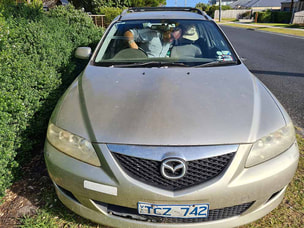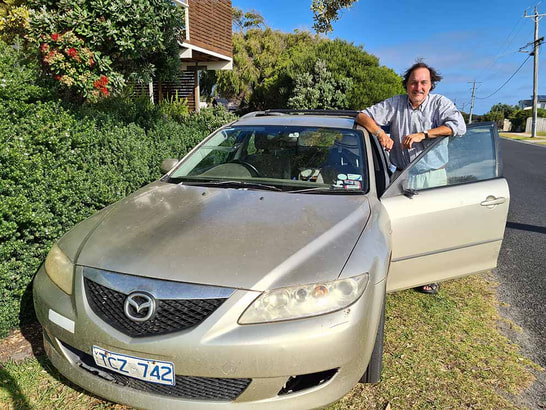“Get rid of personal motor vehicles if you can – and if not keep hold of your existing vehicle for longer”
This is one of six commitments that, according to researchers, if made by people in well-off countries, would account for a quarter of the emissions reductions needed to keep global warming to 1.5C.
I don’t think so; not unless either (or both) the Cape Pat-Wonthaggi bus service improves significantly, or my fitness and pushbike-riding skills skyrocket. I have a 150cc scooter, but in the salty Cape Pat air it’s not faring too well and is unreliable.
Have I held onto my existing vehicle for long enough?
I think so – it’s a 20 year old hand-me-down from my wife, Trish, and has recently started to show its age.
 Entry via the passenger door involves some acrobatics.
Entry via the passenger door involves some acrobatics. For a long time, I’ve told myself my next car will be an electrical vehicle (EV), but when is the right time to jump in?
Like all technologies, EVs get both cheaper and better as time goes by. For me, with my current car’s future looking more tenuous each day, the right time is now. And I think now is the right time for many others too, for two reasons:
- You will all have seen the recent IPCC report. We don’t have the luxury of time any more; none of us. Our ultimate fate will be determined by “Societal choices and actions implemented in the next decade”. Electrifying travel is a big part of the shift – we must all do it, post-haste.
- A new technology is on the cusp of being rolled out in Australia – bi-directional charging, which means you can use your EV as a home battery at night, a big plus (particularly given power outages in Cape Pat) that in time might even allow us to be off-grid.
So, about three weeks ago I signed up to have a Nissan LEAF imported from Japan. It will be a second-hand, 2019-21 model that’s had all the mechanics and electrics checked, been converted to English (I’m learning Japanese at U3A but don’t think I could cope with a kana or kanji dashboard), registered, etc., and ready to “drive away” in about five months.
How did I get from simply thinking I must do something about getting an EV to actually signing up?
First I attended a Bass Coast Sustainability Festival webinar organised by Totally Renewable Phillip Island (TRPI – thanks Mary Whelan and Zoe Geyer). It was presented by the Good Car Co, founded by three Tasmanian academics who would prefer everyone walk or ride but think that, if you must drive, then EVs are the way to go. So they put in the work needed to start a business importing second hand EVs from Japan simply to make affordable, reliable EVs readily available in Australia.
The webinar, stories from others who have bought through GCC, reading their website, and communicating with them directly convinced me these people were reliable and in it for the right reasons. (They are there for the purpose, not the profit.) So, after checking relative price of cars through the usual channels just to make sure their prices are in the right ballpark (which they are – on the less expensive side given their quality assurance processes), I decided to go with them.
What were the deciding factors?
I had, and still have, many questions about EVs, some of which were answered on the webinar. But two critical factors made the whole process far simpler than it would otherwise have been:
- deciding to go with GCC – a supplier I am happy to trust, is in it for the right reasons, and is priced fairly; and
- deciding I want a car capable of bidirectional charging. There are, as far as I can tell, only two EVs in Australia that are capable of bi-directional charging: 2019+ Nissan LEAFs, and a new Mitsubishi model. GCC doesn’t import the new Mitsubishi, so a LEAF it is!
Why is bidirectional changing (or V2G – Vehicle to Grid, V2H – Vehicle to Home) so important?
This is where one could get technical, but in broad terms it is rather simple (which is good, because I’m not technical).
Firstly, bidirectional changing can provide the individual benefits of a home battery – free household energy from solar panels, self-reliance during power outages, and reduced bills. Which, for many, may be enough, but …
Secondly, from a macro point of view, it seems to me (contrary or supporting views welcome – please comment) we are moving to a fully integrated system in which energy is:
- generated where and when conditions are right – wind blowing, sun shining, etc,
- consumed where and when it’s needed – around the clock but with peaks and troughs that are not necessarily in sync with when it’s generated, and
- moderated through a distributed, but integrated, system in which domestic generation and storage plays an increasingly important part.
We already have a massive amount of domestic generation. What we need is a proportional amount of domestic storage. We could all get separate batteries (like Tesla Powerwalls), but why duplicate batteries that will already exist in domestic EVs? Particularly given that batteries are not ecologically neutral – think of rare earth extraction. Here’s a good article about bidirectional charging.
Are all LEAFs the same?
As you can probably tell by now, I don’t much care about the fit-out of the car I drive – any EV will be infinitely better than my 20-year-old Mazda. They will all have digital thises and thats, excellent safety features, “fuel economy” (zero cost from home solar), and whatever else makes cars attractive (upholstery, interior design, sound system, etc.). Admittedly, the LEAF does not have the panache of a Morgan, Alpha or Merc but, fortunately, I’m past that mid-life crisis, which manifested for me about 30 years ago in a “convertible” Suzuki Vitara – not really James Bond material.
The important thing for me is the battery size. I chose a 62 kWh battery that will travel about 300 km on the open road before needing a recharge, which is easily enough to get me to Melbourne, and maybe even back again. Ironically, stop-start driving in town allows for more kms, about 350, between charges because, as I understand it, the battery is being recharged by energy released through braking, which happens more in town than in country driving.
The other choices were a 24, 30 or 40 kWh battery, which have a range of about 90/110 km, 120/150 km and 200/235 km respectively. Of course, the extra range is reflected in the price. I’ll be paying about $50,000. The others are about $17,000, $25,000 and $37,000 respectively.
Expose yourself.
Having exposed some of my thinking here, it would be great if others were to contribute their thinking in the comments below for the benefit of all who may embark on the EV journey in future (probably all of us). For my part, I’ll write another article soon about some of the research I’ve started doing on the practicalities of owning and running an EV (like finding charging stations with the right plug type when planning a long trip) and keep y’all posted when I have something of substance to add re my own experience when the LEAF turns up … watch this space.
Michael Nugent is a member and cofounder of the Bass Coast Climate Action Network.
